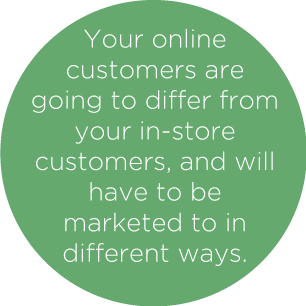If you’ve read this blog at all over the past few months, you know the value we’ve placed on having a website for your small business. It’s absolutely mandatory that you are discoverable on the web so all those millions of surfers out there know you exist. Case closed.
Now that that’s settled, another question that seems to float around the small business circle is whether or not to add an option on your website to allow visitors to buy your products directly from the site.
Should your small business consider adding direct purchasing to your website?
The benefits are readily available, as you are removing as many obstacles as you can for your customer to make a purchase – they don’t have to pick up the phone, they don’t have to travel anywhere, they just need to select what they want, fill out their information, and whatever they want will be on its way soon.
Not too long ago, however, most small businesses didn’t feature a shopping cart fixture on their site, either because their website was too simple to fit it in, or because the person who developed their website wasn’t technologically advanced enough to come up with their own e-commerce system. Those days are long gone – today, there are a myriad of cheap and incredibly easy to implement web store solutions available. And the concept as a whole has been around long enough that many web developers have come up with their own systems, which would allow your site to feature a proprietary method of purchasing (for a bit more coin).
When launching an online store, thorough planning is a must
However, just because it’s easy to implement on your site, doesn’t mean implementing and controlling a full, true e-commerce solution is a breeze. There are a lot of other questions that come along with purchasing from your website. How are the orders going to be ported over to your main system that tracks your in-store purchases? How will you monitor your inventory to ensure that if somebody orders the last of a particular item in your store that it is immediately shown as “Out of Stock” on the website? How are you going to handle shipping solutions, and will you make your products available internationally or just domestically?
These questions (and of course, many more) will present themselves as you begin to contemplate adding some form or shopping cart functionality to your site. Luckily for you, we’re here to help. First things first.
1. Is it worth it to launch an online store for my small business?
 First, it’s wise to determine if adding a shopping cart is worth it for your business. This will become clearer as we discuss several of the shopping cart options later in the article, but the answer is almost certainly yes. There are so many cheap, easy-to-implement solutions for e-commerce that the time and money it will take to get up and running is more than worth all the potential new transactions you’ll be able to nab from people that don’t live in the immediate vicinity of your business. But there are exceptions to the rule. If you dabble in services instead of goods and products, you can probably get away with not offering transactions on your website – you can outline the different service packages in detail on the site (and you should), but odds are that you’ll have to meet with the client in person or on the phone anyway to go over the finer points. If you operate a restaurant or food-oriented business, it might not make sense either – online pickups or delivery are very convenient for the customer, but tend to only work in large cities where there are a lot of customers in a very close vicinity as nobody would like to order something to be delivered only to have it arrive cold and not so fresh.
First, it’s wise to determine if adding a shopping cart is worth it for your business. This will become clearer as we discuss several of the shopping cart options later in the article, but the answer is almost certainly yes. There are so many cheap, easy-to-implement solutions for e-commerce that the time and money it will take to get up and running is more than worth all the potential new transactions you’ll be able to nab from people that don’t live in the immediate vicinity of your business. But there are exceptions to the rule. If you dabble in services instead of goods and products, you can probably get away with not offering transactions on your website – you can outline the different service packages in detail on the site (and you should), but odds are that you’ll have to meet with the client in person or on the phone anyway to go over the finer points. If you operate a restaurant or food-oriented business, it might not make sense either – online pickups or delivery are very convenient for the customer, but tend to only work in large cities where there are a lot of customers in a very close vicinity as nobody would like to order something to be delivered only to have it arrive cold and not so fresh.
But for the most part, if you run a small business that offers products for sale in your store, you should strongly consider adding transactions to your website. It’s no secret that online shopping is huge and continuing to grow – in 2012, e-commerce sales in the United States totaled $289 billion, an increase from 2011’s $256 billion total. Every day you’re not selling your products online is another day where you’re missing out on a piece of that pie – and although your slice will probably be microscopic compared to the whole thing, you might be surprised how much revenue you’ll be able to generate online.
2. So you’ve decided it is worth it. Time to do some research on the various online store front options.
So, what to do now? Research, research, research. There is no shortage of options – popular ones include Bigcommerce, Ashop Commerce, Volusion, Shopify, 3DCart, Shopping Cart Elite, SunShop, X-Cart, Pinnacle Cart, and ShopSite Pro. There are lots more though so take your time and do your homework. Compare the fees to see which best fits your budget (most require a monthly fee but some do quarterly, and some will allow you to reduce that fee in exchange for a percentage of sales). If you’re a smaller business, there are solutions that have a maximum number of monthly orders that will cost you significantly less than the unlimited options – if you’re confident you will move a modest amount of products in a month, look for an option that has a somewhat lower ceiling to make it more affordable. You can always upgrade or switch options later if your online business grows exponentially, although make sure to read the contract carefully to ensure you’re not locked into a long-term deal.
 Also, check in with your website developer to see how the implementation process will go. If they set you up in a WordPress site, there are several options that will be able to be fully implemented within a few hours. If they created something for you from scratch, the process will take a bit longer (and be more expensive unless your developer is on staff and salaried).
Also, check in with your website developer to see how the implementation process will go. If they set you up in a WordPress site, there are several options that will be able to be fully implemented within a few hours. If they created something for you from scratch, the process will take a bit longer (and be more expensive unless your developer is on staff and salaried).
Also, almost all of the options available (including every single one listed above) offer some sort of inventory control – however, you must already have a computerized inventory system to which they can integrate to. If not, that would be step one.
3. You’ve decided on which online store service to use. Now, how are you going to handle shipping, logistics, taxes, etc.?
The last major detail to consider is shipping and taxes, but nearly all shopping cart software solutions (again, including all of the ones previously listed) allow you to customize the amounts to fit whatever shopping solution you decide to go with. If you go with a pricier shipping model that allows for faster deliveries, you’ll be able to accommodate the costs by increasing the price of shipping for each transaction, and even adjust it based on where the product is being shipped.
There are some smaller details to consider as well when you’re evaluating potential options. Some will throw additional features into their package to try and convince you to go with their solution. Extras like SEO optimization, daily deals, coupons and gifts, automated email confirmations, abandoned cart emails, order tracking, customizable shipping and order pages, and more than we have room to type are often thrown into the payment fee. Compare and contrast your leading options to see who offers what and which could be the most beneficial to your business.
An online store can help increase sales and customer loyalty
 As we’ve mentioned before, the biggest upside to having an e-commerce solution on your website is that it eliminates as many barriers as possible between your customers and your products. But your online customers are going to differ from your in-store customers, and will have to be marketed to in different ways. They are going to be a bit more tech-savvy than your average walk-in, so think about offering internet-based coupons to those that purchase online. Integrating your social media pages is a great idea (e.g. – “Like us on Facebook and follow us on Twitter and get 10% of your next purchase!”). The flip side of that coin is that they aren’t likely to come in the store, so promotions about in-store sales might not be as effective on them. What’s great is that you’ll have email addresses for every single customer that purchases from your online store – why not add those to a separate list that you can send specialized email marketing campaigns to that specifically integrate with your online storefront?
As we’ve mentioned before, the biggest upside to having an e-commerce solution on your website is that it eliminates as many barriers as possible between your customers and your products. But your online customers are going to differ from your in-store customers, and will have to be marketed to in different ways. They are going to be a bit more tech-savvy than your average walk-in, so think about offering internet-based coupons to those that purchase online. Integrating your social media pages is a great idea (e.g. – “Like us on Facebook and follow us on Twitter and get 10% of your next purchase!”). The flip side of that coin is that they aren’t likely to come in the store, so promotions about in-store sales might not be as effective on them. What’s great is that you’ll have email addresses for every single customer that purchases from your online store – why not add those to a separate list that you can send specialized email marketing campaigns to that specifically integrate with your online storefront?
And then there’s the question of loyalty – some believe that customers who purchase online are less likely to be loyal to one store than those who come in and shop in person. There is definitely some truth to that notion – online shoppers are much more likely to go with the cheapest price, regardless of brand loyalty. But that doesn’t mean they can’t be loyal at all – according to Intershop, approximately 25% of all online customers are repeat buyers, meaning loyalty does exist online. Viewing your online interactions as just as important as your in person interactions will go a long way toward getting repeat customers – provide excellent customer service and constantly evaluate the purchasing process to make sure as many of your online buyers are happy buyers.
By taking the time to research what shopping cart system works best for your business, your website, and your budget, you’ll be able to arrive at a solution that can tap your business into an exponentially larger group of potential customers than you could possibly reach offline. Getting your first order from somewhere across the world will provide the knowledge that you gained a customer that was impossible to acquire before, and the more of those you reach, the faster your business can grow.






Leave a Comment